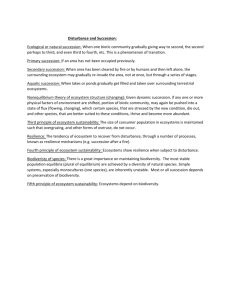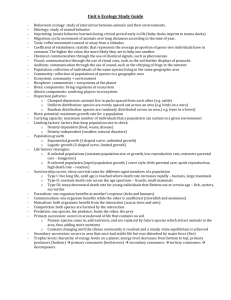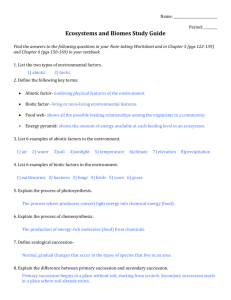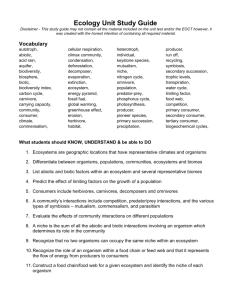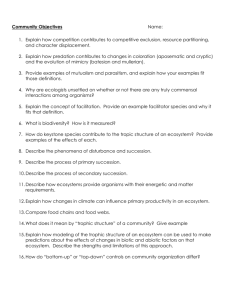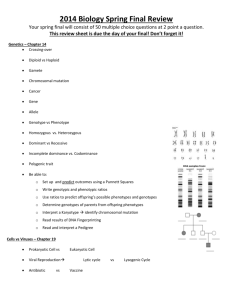Topic: Succession After Disturbance
advertisement
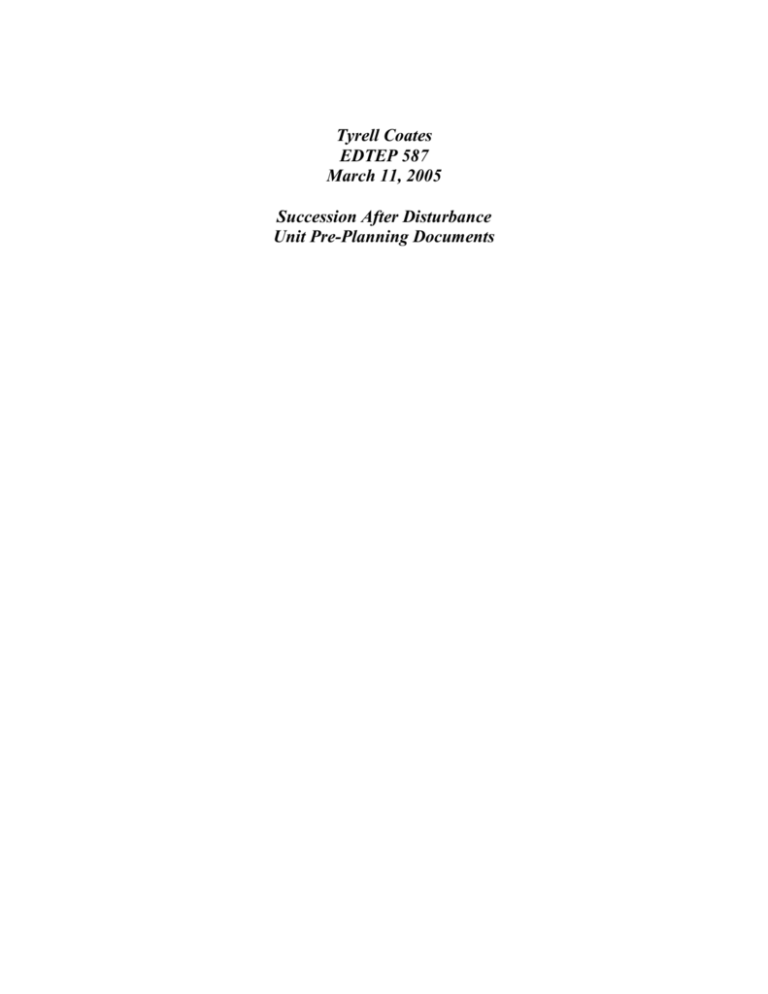
Tyrell Coates EDTEP 587 March 11, 2005 Succession After Disturbance Unit Pre-Planning Documents Topic: Succession After Disturbance EALR 1: The student knows and applies scientific concepts and principles to understand the properties, structures, and changes in…living systems. GLE 1.2.1 Analyze how systems function; including the inputs, outputs, transfers, transformations, and feedback of a system and its subsystems. GLE 1.3.9 Analyze the scientific evidence used to develop the theory of biological evolution and the concepts of natural selection, speciation, adaptation, and biological diversity. (Italicized concepts will be stressed in this unit) GLE 1.3.10 Analyze the living and non-living factors that affect organisms in ecosystems. EALR 2: The student knows and applies the skills, and processes, and nature of scientific inquiry. GLE 2.1.3 Apply understanding of how to construct and revise a scientific explanation using evidence and inferential logic. GLE 2.1.4 Analyze how physical, conceptual, and mathematical models represent and are used to investigate objects, events, systems, and processes. GLE 2.2.1 Analyze why curiosity, honesty, cooperation, openness, and skepticism are important to scientific explanations and investigations. GLE 2.2.3 Evaluate inconsistent or unexpected results from scientific investigations using scientific explanations. EALR 3: The student knows and applies science concepts and skills to develop solutions to human problems in societal contexts. GLE 3.1.3 Evaluate consequences, constraints, and applications of solutions to a problem or challenge. GLE 3.2.4 Analyze the effects human activities have on Earth’s capacity to sustain biological diversity. Atlas of Scientific Literacy NS: Changing environments, level 9-12 (5F6) Variation and advantage, level 6-8, level 9-12 (5D1, 5F2, 5F3) FM: Matter cycling, 6-8, level 9-12 (5E1, 5A5) Rationale Succession after disturbance is a natural phenomenon that encompasses foundational ecological ideas. The key concepts found in this unit are the same concepts that would be found in any ecology unit; studying the concepts through a phenomenon that is occurring in our local ecosystem increases relevance and student interest. To understand succession, students must understand an array of scientific concepts: types of disturbance because they set succession into motion, reproductive strategies because they determine which organisms can colonize and succeed in disturbed areas, population interactions and niches because they are key to species survival and subsequent composition of plant communities, natural selection because it is the driving force in deciding this species survival, biotic and abiotic resources because their availability determines which species can live in a disturbed environment, and consideration of human impacts on ecosystem health because students need to assess their own role in disturbance and succession. By learning these topics, students will follow succession from beginning to end, plus consider these topics in a real, bioethical context. Furthermore, succession provides a relevant schema for students to attach these larger ideas, which are found in the EALRs and the Atlas of Scientific Literacy. Students must also be proficient in experimental design, performance, and analysis to complete the summative assessment for the succession unit. Besides enriching students’ content knowledge, the succession unit creates the opportunity for students to become scientifically literate citizens. Succession, of course, is caused by environmental disturbance; much of this disturbance is due to development and agriculture by human beings. It is not my goal to turn my students into environmentalists, but to give students to understand the changing ecosystem around them and its political ramifications. For example, the summer of 2005 is sure to be fraught with forest fires, and through the succession unit students will be able to understand why the fires happen and how the forest restores itself. Also, the succession unit would naturally lead into units about evolution and classification, respectively. We will discuss natural selection in the context of plant community composition, and we can apply that introductory understanding to natural selection as the driving force for evolution. Then, students will need a system of understanding the rich diversity of organisms created by evolution, so classification will follow up nicely. Nothing would precede this unit; succession is a highly-relevant topic that will give students a thorough introduction to significant biological ideas, and I would like to take advantage of the good weather in September for a field trip! Critical Attributes Ecosystem disturbances create patterns of succession (primary, secondary, climax community) that vary in diversity and distribution, and are necessary for ecosystem health. Natural selection of species in a given ecosystem occurs via the availability of and species’ interactions with abiotic and biotic resources, thus shaping community composition. Plants partake in a variety of population interactions and reproductive strategies to outcompete and thrive in plant communities. Natural selection and competition create niches for organisms that are key to species and community success. The success of succession and overall ecosystem health can be assessed by studying common indicators of health, such as biodiversity, species distribution, and environmental context. Essential Question: Entire Unit: How do we get from fire to forest? Subquestions: What’s your niche? How can we tell if an ecosystem is healthy? Description of Culminating Project As a summative assessment, students will assess the health of a local ecosystem by choosing an indicator of health and quantifying it using a data chart. This summative assessment will take the form of a guided inquiry. First, I will pose the question “How do we tell if an ecosystem is healthy?”, and students will choose indicators of ecosystem health that they deem most important, and give a rationale for their choices. Before collecting data, I will help the class create an initial model of the factors that indicate ecosystem health. This section will be heavily guided! Then, students will collect data on the ecosystem behind Bellevue High School, and analyze their data to make conclusions about community health. As a class, we will then refine our model and identify further questions created by the inquiry. The students will be responsible for turning in their data, complete with rationale, conclusions, and refined models. Backward Planning 1. Ecosystem disturbances 2. Types and purposes of succession 3. Biotic and abiotic resources 4. Reproductive strategies 5. Competition 6. Natural selection 7. Population interactions 8. Niches 9. Plant communities 10. Assessing ecosystem health (theory) 11. Assessing ecosystem health (practice) 12. Relating ecosystem health to human impacts


